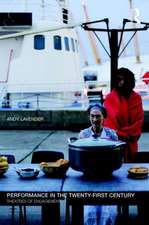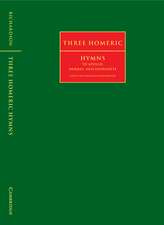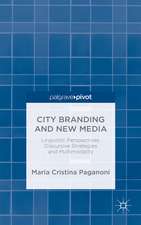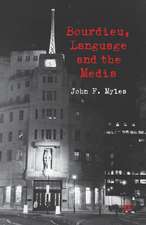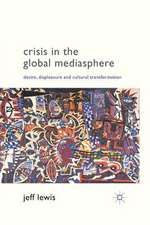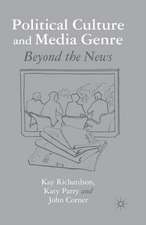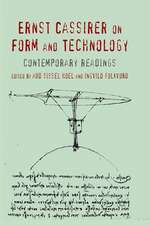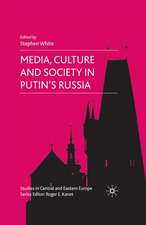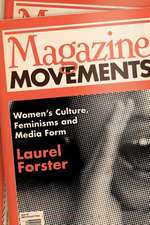News Media Influence on Rail Infrastructure Policy
Autor Nicholas Richardsonen Limba Engleză Paperback – 28 mai 2025
Preț: 250.59 lei
Nou
Puncte Express: 376
Preț estimativ în valută:
47.96€ • 49.47$ • 40.59£
47.96€ • 49.47$ • 40.59£
Carte nepublicată încă
Doresc să fiu notificat când acest titlu va fi disponibil:
Se trimite...
Preluare comenzi: 021 569.72.76
Specificații
ISBN-13: 9781501387456
ISBN-10: 1501387456
Pagini: 304
Dimensiuni: 152 x 229 x 25 mm
Greutate: 0.45 kg
Editura: BLOOMSBURY ACADEMIC
ISBN-10: 1501387456
Pagini: 304
Dimensiuni: 152 x 229 x 25 mm
Greutate: 0.45 kg
Editura: BLOOMSBURY ACADEMIC
Caracteristici
Provides new approaches for professionals involved in the development and execution of significant policy and projects subject to media scrutiny in order to improve practice and outcomes
Notă biografică
Nicholas Richardson is a lecturer in Strategic and Creative Commercial Communications at the University of New South Wales, Australia. In previous lives he has written speeches for politicians and developed communications strategies for government agencies, NGOs and international companies.
Cuprins
Abbreviations and acronyms Introduction Part I: Following the Actors: A Journey to ANTChapter 1. Discursive Beginnings Chapter 2. The Case for ANTChapter 3. Tracing the Media Hinterland Part II: Metro Development in Sydney Chapter 4. Upheaval: The Media Beast and Political Decision-MakingChapter 5. Policy Demise: Where Have All the Leaders Gone?Chapter 6. A Derailing of Sydney TransitChapter 7. My Kingdom for a Car: The Motoring Mythology Chapter 8. Sydney Metro Comes Full Circle Part III: The Montreal Métro Turns FiftyChapter 9. Wandering the Montreal Métro: Where Do You Come From?Chapter 10. Wandering the Montreal Métro Part 2: What Do You Do? Part IV: Tracing an Actor-network Chapter 11. Chains of Translation Conclusion: Intersecting Pathways Glossary: Summary of Key TerminologyReferences Index
Recenzii
This book employs the Actor-Network Theory (ANT) developed by Bruno Latour, Michel Callon and others in the analysis of two contemporary cases of local infrastructure planning - the Metro projects in Sydney, Australia and Montreal, Canada. The author unearths and dissects coalitions of human and non-human authors, which are often invisible but nevertheless critical for the success or failure of such projects. An insightful read for every academic, practitioner and student fascinated by but also concerned about the 24/7 news cycle and its ambiguous impact on local politics nowadays.
In this book, Nicholas Richardson takes us through the complexities of major infrastructure projects in Australia and Canada. These projects exist through the networks of actors who tell their stories in an ever-changing landscape. In this context, where controlling the narrative is a challenge, communicators must seek political approval for projects to go ahead. To achieve this, they need a fine-grained understanding of actor networks. The book is truly enlightening.
Assembling a motley cast of policy experts, career bureaucrats, communications consultants, election-cycle politicians and opinionated amateurs around the scene of rapid rail networks in Sydney and Montreal, Nicholas Richardson follows the actors in this magnificent account of mediatization, railways and the policy apparatus. Deftly weaving together the complex threads of policy failures and fictions with infrastructural futures, Richardson ensures the reader remains on the rails in this compelling journey into the urban underground.
In this book, Nicholas Richardson takes us through the complexities of major infrastructure projects in Australia and Canada. These projects exist through the networks of actors who tell their stories in an ever-changing landscape. In this context, where controlling the narrative is a challenge, communicators must seek political approval for projects to go ahead. To achieve this, they need a fine-grained understanding of actor networks. The book is truly enlightening.
Assembling a motley cast of policy experts, career bureaucrats, communications consultants, election-cycle politicians and opinionated amateurs around the scene of rapid rail networks in Sydney and Montreal, Nicholas Richardson follows the actors in this magnificent account of mediatization, railways and the policy apparatus. Deftly weaving together the complex threads of policy failures and fictions with infrastructural futures, Richardson ensures the reader remains on the rails in this compelling journey into the urban underground.


